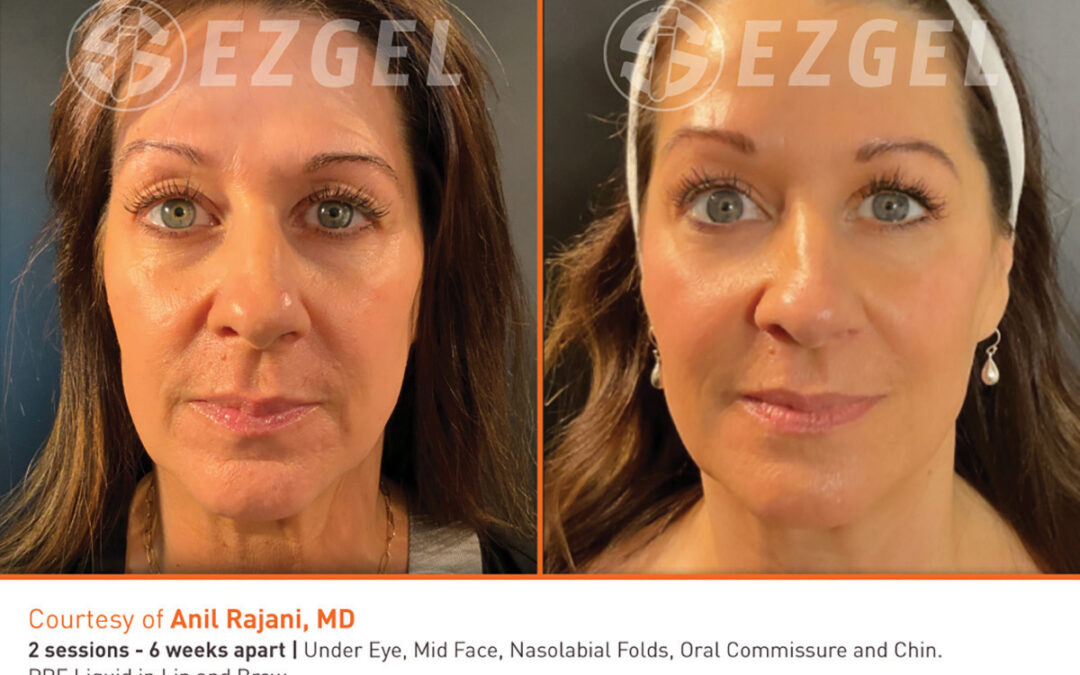Did you have a great summer, playing in sunny San Antonio? Perhaps you ventured to the Texas coast or went tubing or boating or swimming in a nearby lake. Maybe you just drove around town, to and from work, or ran some errands. Either way, if you didn’t use a sun block of SPF 30 or higher on your face, you will have suffered some damage from the sun’s rays. Of course, there are many other ways we obtain those facial wrinkles, brown spots and sagging skin. Bad habits — smoking, drinking, etc. — have been shown to age someone by as much as 12 years, including facial features. And, yes, those pesky hormones play a major role in the aging process, both internally and externally.
Facing life’s changes
Notice some acne breakouts lately? You can try a combination of over-the-counter creams used for acne and for wrinkles. Birth control medicines are said to help. On the other hand, birth control pills might cause you to develop brown, patchy spots. On the other, other hand, as your thyroid decreases the production of hormones — and it will — your skin can be helped with the production of hyaluronic acid. So back to birth control pills? Not necessarily. You can replenish the hyaluronic acid with topical creams. But wait! Since estrogen is stored in fat, losing a lot of weight can make you look older faster because major dieting affects your collagen and elastin levels. Using peptides and retinols can help rebuild collagen. Elastin is more difficult to replace, which means skin becomes looser and less flexible. The formula: Too much skin + too little tissue underneath = wrinkles. Approaching menopause, your skin will start to become thinner and to sag. You may also experience some bone loss in your facial structure that can cause dark circles to appear under your eyes. Now what? Medicating with the pill may cause dehydration and earlier facial “dropping.” Instead, try estrogens made from plants like soy, wild yam or green tea to firm up your face. These products are called phytoestrogens and are said to be safe. Some physicians recommend women start using these in their 40s, because after menopause women lose 30 percent of their collagen within the first five years!
Now, let’s deal with this thing called skin
There are rejuvenation treatments widely available that are considered “noninvasive” cosmetic procedures. Health insurance does not usually cover cosmetic procedures. A few examples:
Chemical peels — usually on the face, neck or hands to reduce fine lines or wrinkles, improve mild scarring, treat some forms of acne, reduce age spots and dark patches caused by pregnancy or birth control pills and generally improve skin texture and color.
Chemical peels require giving a medical history at the doctor’s office and advance preparation of the skin, possibly including oral antibiotics. Pain, peeling, swelling and after-care requirements vary according to the depth of the peel. As in all procedures, you could experience additional complications.
Botox blocks the signals from the nerves to the muscles, causing wrinkles to relax. (Wrinkles caused by sun damage and gravity do not respond to Botox.) Injections take a few minutes; no anesthesia is required, and it takes three to seven days to see the full effect. A treatment lasts about four to six months. You could have temporary bruising, maybe a headache.
Cosmetic fillers are materials injected under the skin to plump up wrinkles, making you look younger. Fillers have been around for many years, but the newer ones last longer and may even be permanent. Collagen, hyaluronic acid and elastin make up a firm, spongy meshwork under the surface of the skin, keeping it smooth and firm. As we age, the meshwork weakens and thins out. Here’s where the fillers come to the rescue. Types of fillers include:
Collagen injections may be natural or synthetic, each form with pluses and minuses. Bovine fillers are manufactured from the skin of cows. They are effective, they cost less, but they can cause allergic reactions, so testing is done prior to injections. Injections need repeating two to four times per year.
Human collagen fillers are made from human cells so they cause fewer allergic reactions, and no testing is required. This collagen is more expensive than bovine collagen. Injections need to be repeated every three to six months.
Hyaluronic acid fillers are a natural part of the support structure, cause very few allergic reactions and can last nine months or more.
Fat injections use small amounts of fat taken from your thighs, belly or buttocks. The fat is then injected under your skin, where it expands the skin, filling out the wrinkles. There are no allergic reactions, and even though results vary, they are sometimes permanent.
Sculptra (poly-L lactic acid) fillers are FDA-approved. Sculptra stimulates the skin cells to produce collagen. This filler is nontoxic and semi-permanent — results can last for months to years.
Radiesse (calcium hydroxyapatite) fillers are also FDA-approved, made from the minerals that give bone its strength and texture. Testing results were significantly better than and lasted longer than collagen injections.
PMMA (polymethyl methacrylate) filler has been used for decades as a cement (yes!) for bone surgery. It is now FDA-approved as a cosmetic filler. It is also nonbiodegradable, and therefore results are permanent.
Dermabrasion and microdermabrasion
In dermabrasion, or surgical skin planing, the skin is frozen, then “sanded” with a specialized instrument. The procedure is used to improve acne scars and other scars, pock marks, wrinkles, age spots and other skin lesions. Dermabrasion is performed under anesthesia in a surgeon’s office or outpatient facility. Afterward, the skin feels “brush-burned,” healing in seven to nine days. Normal activities can be resumed in seven to 14 days. Some complications or side effects can occur.
Microdermabrasion, sometimes called the “power peel,” uses tiny crystals sprayed on skin. It is best used for fine lines, dull skin, brown or age spots and mild acne scars. It is a nonsurgical procedure, and the skin recovers in 24 hours.
Other treatments to try:
Thermage — Newer equipment yields a noninvasive “mini-facelift” using a type of radio frequency. The resulting heat tightens the skin and stimulates collagen production. FDA-approved, it requires no recovery time but can be pricey, depending upon the number of treatments. This process also requires patience, since collagen growth results can’t be seen for three to six months.
Massage is considered by some an anti-aging tool. It keeps the skin firm — “… a workout for our facial muscles.” Kneading the muscle tissue improves blood circulation, which causes oxygen and nutrients to come to the treated area. The result is that collagen fibers in the skin retain their elasticity. Massage should be used on a regular monthly basis. By the way, after 60 years of age, results may not be the same.
Whom do you trust?
“I’m off to the cleaners, the grocery store and then to the mall for a manicure, a haircut and injections in my face.” It’s that easy, what with all the services offered at the large crop of day spas and medi-spas. Convenient? Yes. Safe? Maybe yes, maybe no. Some of these medi, or medical, spas are nowhere near a doctor’s office, but are simply an “umbrella” allowing potentially unqualified employees to treat patients, putting patients/customers at risk. I recently read about a woman who went in for Restylane injections around the lips. While there, she had a gran mal seizure. This was not caused by the injection, but if it had happened in a facility without medical supervision, it could have been a disaster. Another example involved a regular customer of a high-end spa who decided to have a procedure called a “photo-facial.” She made sure the aesthetician was licensed and asked around about her. Unfortunately, the extremely powerful laser was set much too high for her skin. She stopped the treatment because of unbearable pain and left the spa with open, oozing blisters. After looking into the car mirror, she drove straight to the emergency room. The burns were treated, wrapped and still bled for a week. Several painful months later, she ended up with deep scars, destroyed pigment and bills over $10,000 for treating the burns. None of it was covered by insurance because it was all considered part of a voluntary cosmetic procedure.
A recent survey by the American Society for Dermatologic Surgery revealed that 45 percent of their surgeons saw an increase in the number of patients coming in for corrective treatments after a cosmetic procedure by a non-physician had gone awry.
This group also cautions that just because a person has an M.D. after his or her name doesn’t make that doctor an expert in cosmetic facial rejuvenation procedures. Some may have completed a weekend course. It’s wise to seek out a physician familiar with the skin and facial anatomy. Dermatologists, for example, spend three years learning about the skin. Since there are no federal regulations as to who can and cannot perform cosmetic procedures and no laws to guarantee truth in advertising in this area, you must do your own research to ascertain the qualifications of a practitioner. Ask about licenses, look at before and after pictures, use word-of-mouth, and see how accessible the physician supervisor is in the event of an emergency.
Develop a “buyer beware” attitude when it comes to choosing where and whom you trust for your rejuvenation procedures. There are, of course, many safe medical spas with a physician on hand.
A Few Do-It-Yourself Hints:
Change hairstyles and makeup to accommodate aging skin. For example, give up powders and foundations that accentuate wrinkles and lines, switching to a light tinted moisturizer.
Puffy eyes — Place a chilled eye compress, a cold wet tea bag or cucumber slices over lids for five minutes to constrict blood vessels and reduce swelling.
Dark under-eye circles — Use a basic eye cream daily to temporarily plump skin so blood vessels are less visible.
Lines and wrinkles — Essential ingredients in creams and gels include retinol to rebuild collagen levels and antioxidants like green tea and vitamin C to help retain collagen and reduce wrinkles. For sensitive skin, use peptides instead of retinols.
Sagging skin — Use eye makeup tricks. Neutralize the lid, using a light nude-colored shadow from lashes to brow. Define the lash line by dipping a liner brush into gray, brown or black shadow and applying as close to the base of the lashes as possible. This creates a softer, more natural look than pencil liner.
Use brightening eyedrops to remove redness, whiten the whites and make you look more awake.
Avoid dark eye shadows and use the aforementioned flesh-toned hue. Top with a goldish-hued shadow.
After applying blush, add some bronzer along the cheekbones to brighten your whole face.
And — might as well start now preparing your skin for winter weather.









0 Comments